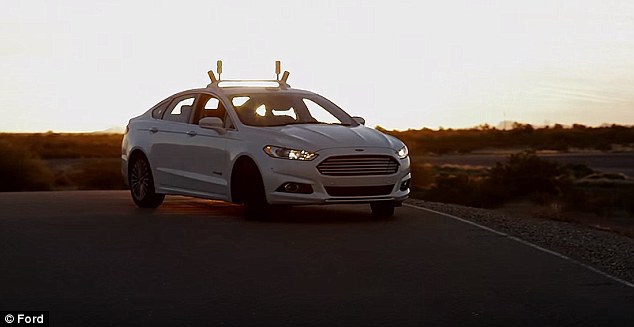The unmistakable glare of car headlights cutting through the darkness on roads at night could soon vanish thanks to new self-driving technology.
Car giant Ford has revealed it is testing the ability of its autonomous vehicles to navigate in pitch black conditions without any headlights.
The cars use laser sensing technology, called LiDAR, to map the vehicles' surroundings with infrared light, allowing them to steer along even the most winding country roads.
Ford said it is essential its self-driving vehicles are able to stay on the road at times of the day when they are not able to use its camera technology as there is not enough light.

The self-driving technology could mean the glare of headlights from passing cars could become a thing of the past. Ford tested its technology at its Proving Ground in Arizona (pictured)
Usually Ford's driverless cars use three separate sensing technologies – radar, cameras and LiDAR – which work with its virtual driver software to steer the car on the roads.
But the company said the cars can also work using just LiDAR when driving on country roads at night.
It could mean the light pollution caused by car headlights at night will become a thing of the past as autonomous vehicles become more common on the roads.
Jim McBride, Ford's technical leader for autonomous vehicles, said: 'Thanks to LiDAR, the test cars aren't reliant on the sun shining, nor cameras detecting painted white lines on the asphalt.
'In fact, LiDAR allows autonomous cars to drive just as well in the dark as they do in the light of day.'
In the United Kingdom, around 40 per cent of collisions occur during the hours of darkness, while in the US more than 40 per cent of fatal accidents occur at night.
To test its technology Ford took its Fusion Hybrid autonomous research vehicle out into the desert at its Arizona Proving Ground.
The headlights were turned off and all internal lights in the car were covered using black cloth and tape.
A LiDAR system mounted on the roof sends out 2.8 million laser beams pulses a second in a grid that maps the surrounding area in real-time and this is added to additional information from the radar.
This is then combined to high-resolution 3D maps used by the cars which help it determine where the road goes, the surrounding topography and landmarks.
During the test, Ford engineers wore night-vision goggles to allow them to monitor the vehicle as it drove around the test road.
Wayne Williams, a Ford research scientists and engineer, rode in the car to monitor its progress.
He said: 'Inside the car, I could feel it moving, but when I looked out the window, I only saw darkness.
'As I rode in the back seat, I was following the car's progression in real time using computer monitoring. Sure enough, it stayed precisely on track along those winding roads.'
-Daily Mail




